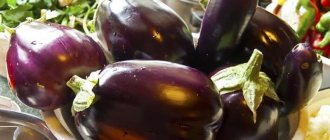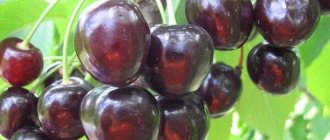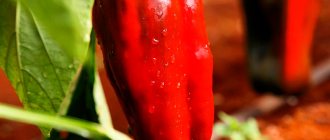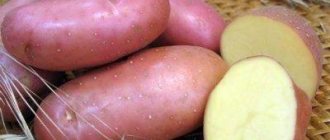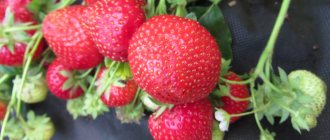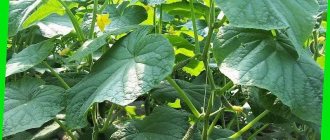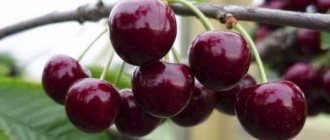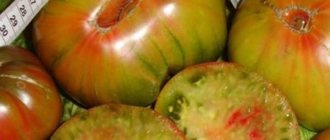Description of the French black cherry variety
Characteristics of the French black cherry variety.
Western European cherry variety of late flowering and ripening (late June). The purpose of the fruit is universal, the fruit has good dessert qualities and produces high-quality products during technical processing and freezing.
The tree is vigorous, the crown is broadly rounded, spreading, dense, well-leafed, slightly drooping, highly branched. Annual shoots are light brown with a gray coating, without anthocyanin coloring. The vegetative bud is cone-shaped, medium in size, the generative bud is oval, located at an angle of 45° relative to the shoot. The leaf is above average size (1.61 x 7.8), oval or elongated-ovate, dark green, medium thickness, elastic, the apex is strongly pointed, the base is broadly wedge-shaped, the edge is coarsely biserrate, the upper surface is smooth, the lower surface is pubescent mainly along the veins. The plate is slightly raised at the edges. The petiole is of medium size (4.0-5.5 cm) and thick, intensely colored, has two medium-sized round glands, often located oppositely on the petiole. The flowers are medium in size, collected in inflorescences of 2-4 flowers, the petals are white, slightly touching. The main flowering and fruiting is concentrated on bouquet branches of various ages and partly in the lower part of the shoots of the previous year.
The fruits are large (average weight 6.5 g, maximum 7.5 g, size 2.4 x 2.2 x 2.3, elongated oval, small, deep funnel, rounded apex, slightly depressed. Fruits are dark red, full when ripe, almost black. The pulp is dense, dark red with light veins, juicy, good taste (tasting score 4.5 points). The juice is intense dark red. The seed is medium size (90.4 g), elongated oval, beige in color. , the apex is slightly pointed, the base is rounded, separates from the pulp well. The peduncle is of medium length and thickness. The fruits are beautiful, shiny, ripening at the same time, the separation from the fruit is almost dry, resistant to cracking. Contains 13.3% dry matter, 18.5% sugars , 0.8% acids, 7.7 mg/100g ascorbic acid.
In extreme weather conditions of the winter period, the cherry variety exhibits fairly high winter hardiness of wood and generative buds; the buds are not resistant to early drops in temperature; during the flowering period, the resistance of the flowers is average, but they are rarely subject to frost. Drought resistance is high. The variety is practically resistant to the main fungal diseases (coccomycosis, moniliosis, hole spot) and is moderately resistant to the cherry fly.
It begins to bear fruit late - at 6-7 years; the trees are long-lived and provide industrial fruiting for up to 25 years. Almost self-sterile. It is characterized by high productivity, the average yield of the French black cherry variety is 8.5-10.5 t/ha, the maximum reaches 18-19 t/ha.
The value of the variety: fairly high winter hardiness and productivity, large-fruited, high dessert and technological qualities of the fruit. Disadvantages: unstable to early winter frosts, vigorous growth.
The cherry variety has been zoned and approved for use in production in the North Caucasus region. The most common variety in the Krasnodar region.
French Black - Cherry plant variety
Variety characteristics:
Properties of the French Black variety:
Recommended region on the map:
Information on the admission of French Cherry Black from the Register of the State Variety Commission of the Russian Federation
Application for admission No. 625, registered 1941-12-30. The French Black Cherry variety was included in the register of those approved in 1959. Approved for use in the regions: North Caucasus.
The originator of the French Black Cherry variety is:
Other plant varieties Cherry
Search for variety by name
Variety selection
Question to the portal experts
If you haven't found the answer to a question, don't hesitate to ask an expert.
Register or Login so you don't have to enter your Name and Email every time
Thanks for the comment! It will be published after checking by a moderator!
No comments yet, be the first!
A portal for those who love their dacha
Your question has been sent for moderation. Don't worry, we quickly check your questions and your question will be answered within 1 day.
Description of culture
Description of the French Black cherry variety:
- great growth power;
- the crown is wide, spreading, round in shape;
- shoots branch well, hang slightly to the ground;
- annual branches are light brown with a gray coating;
- leaves are oval, measuring about 16x78 mm;
- the leaf blade is smooth, oval or elongated, dark green;
- the tips of the leaves are pointed.
Cherries produce medium-sized white flowers. Flowers bloom in inflorescences of 2-4 pieces.
The fruits are large, average weight 6.5 g, maximum - 7.5 g. The shape is elongated-oval, with a small funnel, size 24x23 mm. The color is dark red, becoming more saturated when ripe, almost black.
Read also: Apricot pruning: spring, summer and autumn, diagram, how to do it correctly, when is it best
The pulp is rich red, juicy, and high density. Taste qualities are rated 4.5 points. The juice is sweet, dark red.
The fruits have high commercial properties, do not crack, and the stalk comes off easily. The pulp contains dry substances (13.3%), sugars (18.5%), acids (0.8%), ascorbic acid (7.7 mg/100 g).
According to its characteristics, the French Black cherry variety is suitable for planting in the North Caucasus and other southern regions.
Characteristics
When choosing a cherry variety, pay attention to its characteristics: resistance to drought, winter frosts and diseases, flowering period and fruit ripening.
Drought resistance, winter hardiness
The French Black variety is highly resistant to drought. The tree receives moisture after rains or from deep layers of soil.
Cherry shows high winter hardiness of buds and wood. With an early drop in temperature at the end of autumn, fruit buds suffer. According to reviews of the French Black cherry, the fruit buds are not susceptible to frost.
Pollination, flowering period and ripening time
The variety is self-sterile; pollinators must be planted to obtain a harvest. The best pollinators for French Black cherries are the Melitopolskaya, Krupnoplodnaya, Krasa Kubani, Black Napoleon, Ramon Oliva, and Prestizhnaya varieties.
Flowering occurs in May. The fruits ripen late. The harvest is harvested at the end of July.
Productivity, fruiting
French Black cherry begins to bear fruit in 6-7 years. The trees bear fruit for a long time, lasting 25 years.
Sweet cherries stand out for their high and stable yields. The largest yield (about 65 kg) is produced by a tree aged 15 years. The maximum recorded yield is 184 kg.
Area of application of berries
The fruits have a universal purpose. They are used as dessert and decoration for confectionery products. Cherries are frozen or processed to produce homemade preparations (jam, juice, compote).
Resistance to diseases and pests
The variety is not susceptible to the main fungal diseases of the crop: coccomycosis, moniliosis, hole spot. Resistance to pests is at an average level.
Advantages and disadvantages
- high winter hardiness;
- stable yield;
- large fruits;
- high commercial and taste qualities of cherries.
Disadvantages of the French Black variety:
- exposure to early winter frosts;
- tree vigor.
Description and characteristics of the Black Prince variety
Designed for cultivation in temperate climates, it tolerates cold weather well, in winter – frosts of 30˚C. When the branches freeze, the tree continues to bear fruit; there is no interruption in fruiting.
Cherry Black Prince grows up to 3.5 m, it has a medium spreading crown and strong growth. There are many leaves, they are wedge-shaped and bright green in color. The variety is self-sterile, so the tree needs a pollinator - a cherry tree, which blooms at the same time as it.
The tree begins to bear fruit in the 3rd year, the yield is over 20 kg per plant. The berries of the Black Prince are dark, maroon in color, large, weigh 5-9 g. With a characteristic aroma and taste, juicy. Cherry ripening occurs in July. The berries can be eaten fresh, processed into sweet preparations, frozen for the winter, and even dried. When fresh, they do not spoil for a long time.
Landing Features
Cherries are planted at a specified time, depending on weather conditions in the region. Pre-select a location, prepare a seedling and a planting hole.
Recommended timing
In warm regions, work is carried out in the fall after leaf fall. The seedling manages to take root before the onset of cold weather. In the middle zone, planting is postponed until spring, before the buds swell.
Choosing a suitable location
For cherries, choose a sunny, warm area. The crop is not planted in lowlands where moisture and cold air accumulate. The permissible groundwater level is more than 2 m.
Cherries prefer loamy or sandy loam soil. Coarse sand is added to clay soil, and organic matter is added to sandy soil.
What crops can and cannot be planted next to cherries?
Cherries are planted in groups of 2-4 varieties. It is not recommended to grow raspberries, currants, and hazels next to the crop. Cherries are removed 3-4 m from apple trees, pear trees and other fruit crops.
Selection and preparation of planting material
One- or two-year-old seedlings are suitable for planting. Before purchasing, inspect the shoots and root system. Healthy planting material does not have cracks, mold or other defects.
2 hours before planting, the roots of the seedling are immersed in clean water. If the root system is dried, it is kept in water for 10 hours.
Landing algorithm
Planting procedure:
- Dig a hole 1 m in diameter and 70 cm deep.
- Compost, 150 g of superphosphate, 50 g of viburnum salt and 0.5 kg of ash are added to the fertile soil.
- Part of the soil is poured into the hole and waited until it shrinks.
- After 2-3 weeks, the remaining soil is poured and a seedling is placed on top.
- The roots of the cherry tree are covered with soil and the plant is watered abundantly.
Read also: Cherry Helena: description of the variety, photos, reviews
Subtleties of caring for the variety
No less important than proper planting is further care of the plant. The work package includes watering and feeding, pruning and preparation for winter.
Watering and fertilizing
For the first 1.5 months, until the seedling grows new roots, it needs to be watered every week. The first season is every month. An adult tree needs to be watered when there is no rain, especially after flowering, when the berries are forming and filling. In the first year after planting cherries, fertilizers are not applied. In subsequent years, fertilize 3 times a year: in the spring, before the leaves bloom, before flowering and in the middle of the period of berry formation.
You can use mineral fertilizers or add organic matter: 1 bucket of humus and 1 kg of ash for each plant.
Pollinators
Cherries of other varieties should be planted close to the Black Prince. At the same time, the varieties Podbelskaya, Brunette, Griot, Apukhtinskaya, Kentskaya, and Valery Chkalov bloom. For successful pollination, 1 tree per 3-4 Black Prince cherries is enough.
See also
How to treat cherries against diseases and pests, what to do for treatmentRead
Preparing for winter
In the fall, after pruning, the soil around the cherry trunk is covered with a thick layer of mulch. You can use old straw, hay, sawdust, clean fallen leaves or dense agrofibre.
Subsequent care of the crop
Cherries are watered three times during the season: before flowering, in mid-summer and before winter. Each tree requires 2 buckets of water.
The French Black variety is fed in early spring. 15 g of urea, superphosphate and potassium sulfate are embedded in the soil. After harvesting, the tree is sprayed with a solution containing 10 g of phosphorus and potassium fertilizer per 10 liters of water.
When growing French Black cherries, pruning is carried out annually. The conductor and skeletal branches are shortened. Dry, frozen shoots that thicken the crown are cut off.
Only young trees need shelter for the winter. They are covered with agrofibre and spruce branches. To protect the trunk from rodents, use roofing felt or mesh.
Black cherries: varieties and their characteristics
Cherries have a juicy taste and bright aroma, which is why they are very popular. Gardeners especially appreciate the early fruiting of the crop, because the tree, depending on the variety, can bear its first fruits as early as early June. Black varieties of cherries, which combine practical characteristics, appearance and taste of the berries, have received great attention.
Pros and cons of cherries
Advantages of the Black Prince variety:
- cold resistance;
- precocity;
- resistance to diseases and pests;
- moderate tree height;
- productivity;
- large-fruited, keeping quality and universal use of berries;
- good taste and aroma.
Disadvantages of the variety: pollinators are required.
Beneficial features
Cherry berries contain a lot of vitamins and microelements that are necessary for the human body. In addition to potassium, iron and iodine, the fruits are rich in citric, malic, salicylic and lactic acid. In addition, they have a low calorie content, which has a beneficial effect on the figure of people on a diet.
Eating berries allows you to normalize metabolism and slow down the aging process. The vitamins A, B1, B2, B3 and B6 they contain help form bones and teeth, and stimulate brain and heart activity.
With the help of cherries you can reduce blood clotting and remove excess cholesterol from the body. Black berries are also necessary for people suffering from hypertension, since dark varieties can lower blood pressure and strengthen the walls of blood vessels.
Black varieties of cherries have a beneficial effect on the human nervous system and help cope with irritability, insomnia and headaches. People with problems with the gastrointestinal tract and diabetics should limit the consumption of these fruits.
Otherwise, cherries can be eaten by anyone.
Description of varieties
Black cherry fruits are dark in color and have a sweet and sour taste. It is best to pick them before they are fully ripe, as overripe berries may burst.
Among the black varieties, the most popular are:
- "Black Prince";
- "Leningradskaya black";
- "French black";
- "Black Sweetness";
- "Rossoshanskaya";
- "Mlievskaya";
- "Daybera";
- "Melitopol";
- "Ilchishina."
"Leningradskaya black"
It is characterized by frost resistance and endurance. It takes root well in areas that do not have hot summers and warm winters. Even being in a place that does not have an abundance of sunlight and heat, cherries consistently produce a good harvest.
The tree grows to a height of 4-5 m and is capable of bearing the first fruits already in the third year after planting. The plant grows so that its branches form a dense crown that does not allow air and sunlight to pass through. You can recognize the Leningradskaya Chernaya variety by its large elliptical leaves and sharp tips.
The crop blooms in May, and the first harvest can be obtained at the end of June. In the coldest areas, the first fruits can be harvested a little later - at the end of July. At the same time, the berries of this variety ripen unevenly, which allows you to enjoy their pleasant taste for a long time.
"Black Sweetness"
It is characterized by partial self-fertility and cross-pollination, which allows for better ovaries. This variety is frost-resistant and easy to care for. He is not afraid of coccomycosis, a disease that negatively affects the yield and viability of the plant.
Read also: Reproduction of spirea: seeds, cuttings, layering and division, World of Gardening
“Black Sweetness” blooms at the end of May, and bears its first fruits in July. Its berries are medium in size and have a dark burgundy color. Their flesh is dark red in color and has a sweet taste.
"Black Prince"
It grows up to 3-3.5 m and has a medium spreading crown. It is not afraid of frost and is resistant not only to diseases, but also to pests. An adult plant can produce more than 15 kg of berries, and with proper care this number can increase significantly. “Black Prince” bears its first fruits in early June and has large berries of a dark burgundy color.
This variety is self-sterile and therefore needs pollinators. In order to get a stable harvest, other varieties should be located near the cherries, for example, “Iput” or “Fatezh”.
Cherries grow in temperate climates and can take root even in the middle zone of the country.
In the southern regions, “Black Prince” seedlings can be planted in the fall, but in cold places they can only be planted in the spring.
"Rossoshanskaya"
A medium-sized, self-fertile plant with a pyramidal-stack-shaped crown and an average number of leaves. A young plant can produce more than 5 kg of yield, while mature cherries have a yield of more than 16 kg. The variety is quite frost-resistant, and therefore can be grown in central Russia. But unexpected frosts during budding and flowering can damage the tree.
The berries are almost black with a red tint. They are distinguished by their large size and round or oval shape.
Description of varieties of self-fertile black cherries: Melitopol, Daibera and French
Cherries are sometimes called bird berries because birds love to eat them. But not only birds like it. Cherries have captivated us not only with their excellent taste, but also with their beneficial properties: the fruits contain pectin, vitamins, microelements, as well as coumarin, which gives the body strength and promotes a speedy recovery after a protracted illness. It has a beneficial effect on the functioning of the heart, liver and kidneys.
The main advantage of cherries among other fruits is that they are one of the first to appear on our tables. About 4 thousand varieties are known, differing in taste, size, and color of berries - from almost white to dark almost black. In the article we will talk about such varieties of black cherries as Melitopol, Daibera, French.
Features of black cherry varieties
Blooming cherry tree
An increased amount of fructose and natural acids helps improve the functioning of the pancreas and gastrointestinal tract. Fruits with a dark color are more reliable for transportation.
Variety Melitopol
Cherry variety Melitopol
A mature tree is quite tall with a rounded, sparse crown. The berries are large, one-dimensional, weighing up to 8 g, colored in a rich burgundy, reaching black color. Ripening later.

